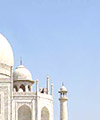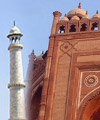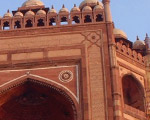|
Faizabad

Faizabad, 7km. from Ayodhaya,developed as a township nearly 220
years ago, during the reign of Safdar Jung, the second Nawab of
Avadh ( 1739-54 ), who laid its foundation by making it his army
headquarters.
Shuja-ud-daula, his successor settled at Faizabad after 1764 and
built a fort known as Chhota Calcutta, now in ruins. In 1765, he
built the Chowk and Tripaulia and subsequently laid out the Anguribagh
and Motibagh to the south of it, Asafbagh & Bulandbagh to the
west of the city.
During the reign of Shuja-ud-daula, Faizabad attained prosperity
which it never saw again. The principle achievement of the period
was the mausoleum of Shuja-ud-daula, famous as Gulab Bari. It is
a striking building of fine properties, standing in a garden surrounded
by a wall, approachable through two large gateways.
Shuja-ud-daula's wife was the well known Bahu Begum, who married
the Nawab in 1743 and continued to reside in Faizabad, her residence
being the Moti-Mahal. Closeby at Jawaharbagh lies her Maqbara, where
she was buried after her death. It is considered to be one of the
finest buildings of its kind in Avadh, which was built at the cost
of three lakh rupees by her chief advisor Darab Ali Khan.
A fine view of the city is obtainable from top of the Begum's tomb.
Bahu Begum was a woman of great distinction and rank.
Most of the Muslim buildings at Faizabad are attributed to her.
From the date of Bahu Begum's death, till the annexation of Avadh,
the city of Faizabad gradually fell into decay.
The glory of Faizabad eclipsed with the shifting of capital from
Faizabad to Lucknow by Nawab Asaf-ud-daula.
Excursion
Fort Calcutta
Fort Calcutta was constructed by Shuja-ud-daulah after he suffered
defeat at the hands of the British, in the Battle of Buxer in 1764.
The fort has massive clay ramparts. The Nawab lived here, and after
his death on the 26th January, 1775, it continued to be the resident
of his widow, Bahu Begum. After Shuja-ud-daulah, the fort declined
in importance and Lucknow became the seat of power of the next Nawab,
Asaf-ud-daulah.
Mausoleum of Bahu Begum
Built in 1816, the mausoleum of Bahu Begum is ‘the finest building
of the kind in Oudh’. Built in white marble, it is 42m high.
Gulab Bari
The plan and chief features of this building are taken from Gulab
Bari, another important monument at Faizabad. Bahu Begum, widow
of Shuja-ud-daulah, fell prey to the conspiracy hatched by Asaf-ud-daulah
in connivance with the British East India Company.
The role of Warren Hastings (1774-85), the first Governor General
of Bengal, in the whole episode is not above reproach.
They tried to deprive the widow of the immense wealth which she
had inherited from her husband.
Mausoleum of Shuja-ud-daulah or Gulab
Bari
Situated 2.5km from the Mausoleum of Bahu Begum, the mausoleum of
Shuja-ud-daulah was built in 1775. The ground floor contains three
tombstones.
The tomb in the centre is that of Shuja-ud-daulah, while to its
left lies the tomb of his mother. The third one is that of his father.
The complex also houses a mosque and an imambara (tomb of a Shiite
Muslim holy man). The imambara lies to the south of the tombs.
Museum
There exists a fine museum in the Guptar Park, near the Guptar Ghat.
Within the park lies a temple, located at the place from where Rama
is believed to have disappeared.
There are some beautiful temples at the Guptar Ghat such as Chakra
Harji Vishnu Temple and Gupta Harji and Raja Mandir. Imprints believed
to be of Rama’s feet have been found in the Chakra Harji Vishnu
Temple.
Top
Getting There
By Road
The city is about 130 k.m. from Lucknow, 200 k.m. from Varanasi,
160 k.m. from Allahabad, 140 k.m. from Gorakhpur and about 636 k.m.
from Delhi. Buses are frequently available from Lucknow, Delhi and
Gorakhpur. Buses are also available from Varanasi, Allahabad and
other places as per their shedule.
By Rail
Trains are available from Delhi, Lucknow, Varanasi and Allahabad.
By Air
Faizabad has an Airport at Naka, near Dr. Ram Manohar Lohia University
but no regular airlines services are available. Nearest airport
is Lucknow (about 130 k.m.).
Weather
The Climate of the district may be treated as normal. The effect
of rains, winter and summer are not very harsh. So a pleasant whether
remains throughout the year. Usually the summer expands from april
to July, the rainy season from August to September and the winter
from October to March.
Temperature
Maximum - 43.7 °C
Minimum - 2.2 °C
Rainfall Normal : 1035 mm.
Top
General Information & Accomdation info on Faizabad city of Uttar
Pradesh - India
|







